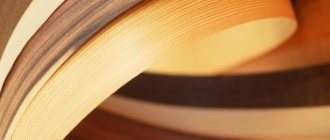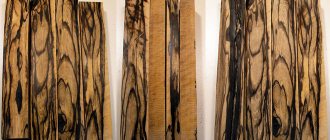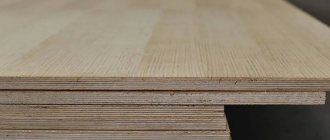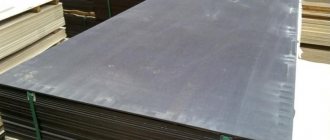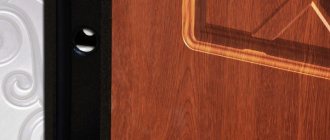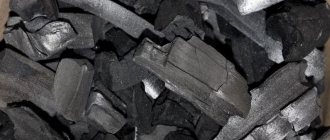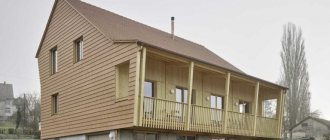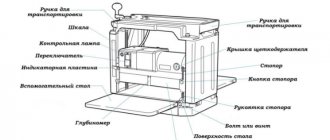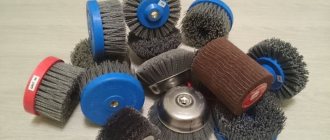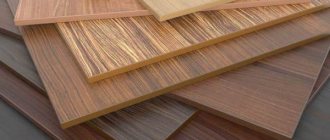Given the choice, the vast majority of consumers will prefer to purchase furniture, interior doors and door frames, and window frames made of natural wood. They are beautiful, reliable, durable. However, you will have to pay a lot of money for them, and not everyone can afford such acquisitions and not always. But you can buy products made from cheap materials that have a finish - wood veneer. It covers the surface of furniture or structures in order to give them an aesthetic appearance. Externally, such products look like they are made of natural wood. Next - more about what veneer is and what types of this material are used in industry.
Definition
Veneer is thin layers (sheets) of wood, their thickness ranges from 0.01 to 1 cm. They are used to glue the surfaces of furniture, room doors, panels, etc. for decoration using special adhesives that meet environmental requirements. As a result of veneer cladding, structures made of chipboard, fiberboard and other materials look beautiful and elegant.
Currently, many varieties of veneer are produced. For this purpose, valuable wood is used. It looks beautiful and gives furniture or other items the appearance of being made from real wood. The color of the veneer can be different - creamy white, dark chocolate, reddish, golden, etc. The pattern completely conveys the pattern of natural wood, which no technical means can recreate.
The type of veneer depends on the type of wood from which it is made. And this can be almost any wood used in industry. But more often than others, the following breeds are used for this.
- Nut. This material is of high quality. Therefore, walnut veneer is used in the production of musical instruments (grand pianos), furniture, and interior doors. The beauty of such products brings a special charm to the interior. The color of furniture walnut veneer varies from light beige to brownish brown.
- Cherry. Cherry wood veneer has interesting orange-brick tones. They are used to decorate luxury, expensive furniture.
- Oak. This type of veneer has increased strength and is used for carpentry work. Products finished with it will last a long time without being damaged. Oak veneer is expensive, but its high quality justifies the cost. Colors and shades range from yellowish-beige to dark brown.
- Maple. There are many varieties of maple used in the industry, and all of them can be used to produce veneers in the light shades characteristic of maple wood.
- Karelian birch. This veneer has an unusual, pleasant pattern and a beautiful pearlescent sheen. Its beauty will not leave even the most picky consumer indifferent.
- Pine. Light veneer is made from it, sometimes with a pinkish tint. Furniture with such a coating looks interesting and aesthetically pleasing.
Other types of wood are also used for the production of veneer. Veneer is made from larch, almost equal in strength and other properties to oak. It is not afraid of moisture and is resistant to rotting. The unusual pattern of annual rings gives it a decorative appearance. Beech, alder, ash, elm, aspen, poplar, fruit trees, etc. are also used. Sliced veneer is made from them in accordance with the requirements of GOST 2977-82.
GOST 2977-82 Sliced veneer. Specifications
1 file 49.82 KB
Characteristics, advantages and disadvantages of veneered doors
A characteristic feature of veneered structures is a huge variety of colors, a high level of noise insulation and environmental friendliness of the products. They have a number of advantages, for which buyers are increasingly choosing them:
- affordable price, products are much cheaper than solid wood products;
- a wide selection of models in color, pattern, texture and type of wood;
- durability - service life is 5-10 years, and sometimes more;
- veneer cladding can be restored;
- the coating can withstand humidity up to 60%, thanks to which such doors can be installed in almost any room;
- lightness - door weight varies from 17 to 30 kg.
Despite the huge number of advantages, veneer doors also have disadvantages: sensitivity to high humidity, for example, if such products are installed in the bathroom, then contact with water should be avoided. At the same time, compared to solid wood structures, veneered products are more resistant to moisture.
Types of veneer
Veneer is a general concept that includes several types of wood finishing material. In industry, different types of this sheet lumber are used, depending on the purpose of the items and the characteristics of the raw materials. For their manufacture, different types of wood are used, as well as various technologies. When finishing furniture, panels, stairs, special bent elements are formed. There are several veneer production technologies.
Sliced veneer
Sliced veneer, which has a certain thickness, is made from the wood of coniferous trees, beech, birch, hornbeam, etc. It is preferable to use wood species with core rays for this purpose. They have an original texture. Its features determine several types of finished material.
The first of them is radial veneer. The annual layers of a tree trunk appear on it as parallel longitudinal lines. The core rays are in the form of strips of unequal width. The second type of sliced veneer is semi-radial. The annual layers are visible over most of the leaf surface; the medullary rays look like stripes located obliquely or longitudinally. The third is tangential veneer. On it, the annual layers are located in the form of inclined cones or curved lines, like the medullary rays. And the fourth is end-tangential veneer. On its surface, the annual layers are visible as curved lines forming closed figures; the medullary rays form strokes or uneven lines.
Sliced veneer is made by planing a piece of wood using a veneer planer. To increase plasticity, the wood is preheated to 30-60 °C. It also reduces the size and number of cracks.
Veneer obtained by planing is divided into 2 grades. The first grade includes products without flaws, or with minimal, barely noticeable cracks, stains, and scratches. The second grade allows the presence of such defects in small quantities, this is determined by the current standard. Certain roughness values are allowed for the surface. Products made from wood species such as ash, oak, larch, pine, and mahogany can have a roughness of 200 microns. Other rocks should have no more than 100 microns.
Peeled veneer
Peeling is a method of producing veneer by cutting a thin layer of wood from a wooden blank - block. It is installed on the peeling machine and rotates. From its surface, using a knife, the layer is removed in a spiral in the form of a tape. Peeled veneer is a material for the manufacture of plywood, cladding, panels, packaging, etc. It is often used to paste over wooden doors. Its main advantage is that the plates have a large area. This type of veneer is the thinnest: thickness ranges from 1 to 5 mm. Peeled veneer is the most budget-friendly type of such product. Inexpensive wood species are used for its production. This method of making veneer is the cheapest. Even when peeling more expensive wood - larch, cedar, oak, the cost of such veneer will be lower than planed or sawn veneer.
The appearance of peeled veneer is not particularly attractive, so it is not used for cladding furniture. If such a need arises, then various finishing methods are used: varnishing, hot printing, painting. An exception is veneer obtained by peeling wood with the presence of a defect - a random or tortuously uneven arrangement of fibers (kinkiness). This veneer looks impressive and beautiful.
Sawn veneer
The process of manufacturing sawn veneer, as the name implies, involves sawing boards using special equipment. Sawn veneer, or lamella, has a thickness of 0.2 to 1.2 cm. Such veneer is made from any wood, but more often raw materials from hardwood are used for this: ash, oak, beech. This material is the most expensive of all types of veneer. During its production, a large amount of waste remains, and it also requires a lot of labor.
Sawn veneer is most often used for finishing. But besides this, furniture, carpentry, panels, and floor coverings are made from it. It is used for finishing car interiors, as well as for the production of musical instruments, souvenirs: caskets, decorative boxes, etc. This type of veneer is suitable for products with curves and non-standard shapes. Such production from lamella is possible due to its elasticity. At the same time, the strength of the connection of wood fibers does not decrease. And the appearance of products made from lamellas is elegant and aesthetic. Virtually no additional finishing is required. All the beauty of the natural structure of wood is fully visible on such products. They look like they are made of natural wood.
Lamel has a number of advantages that make it popular; products made from it are in demand. In particular, we are talking about the following qualities:
- This material is environmentally friendly, and items made from it are safe for human health.
- The service life of such products is long; when used correctly, they are durable, not subject to deformation, do not crack or fade.
- Lamella coatings have high thermal insulation and sound insulation properties.
- Products made from sawn veneer are not afraid of temperature and humidity fluctuations and are resistant to mechanical stress.
- Such products look great and will decorate the interior of any room.
- The consumption of raw materials is low.
All these advantages are highly valued by consumers. As for the disadvantages, the main one is the high cost of the lamella.
How veneer doors are made
photo from the website https://images.ru.prom.st
Veneered doors are produced in several stages:
- First, a frame is created. An array of pine trees is chosen for it. Wood should have a moisture content of no higher than 8%. This quality allows you to protect the future product from deformation, drying out, cracks, as well as the development of rot and mold.
- One side of the frame sash is covered with an MDF panel 4 mm thick. Filling is placed inside - cardboard or polystyrene foam and sealed with a second panel.
- Then the finishing material is prepared. The width of the panels is up to 30 cm, so stripes with a similar pattern and color are selected. They are laid out so that they mirror each other.
- The selected blanks are placed in a machine, where they are glued together with an adhesive zigzag thread.
- At the next stage, the sheets are cleaned along the seams, excess glue is removed and ground according to the door leaf template.
At the end of the work, the finished sheets are glued onto the assembled door leaf and placed under a hot press, which speeds up the drying process of the glue. In this way, all sides of the sash are pasted over, and then sanded until a perfectly smooth and even surface is obtained. The finished door is coated with varnish, which improves aesthetic and performance properties.
Using this technology, hollow doors are made, and the solid door is assembled from glued timber, which is then decorated with veneer.
Production technology
The quality of veneer depends primarily on the material used for its manufacture. For this purpose, straight, slender tree trunks with few branches and twigs are used. However, wood processing technology is also of great importance. It is carried out according to approved instructions. The quality of the resulting products must comply with currently valid GOSTs.
Veneer production by one method or another - sawing, peeling, planing - is carried out at woodworking enterprises. First of all, heat treatment is carried out, which increases the elasticity of the wood. The log is then stripped of its bark. Before starting work on veneer production, specialists evaluate the material and determine the best processing method. To obtain veneer, specialized equipment is used. Many craftsmen make veneer with their own hands.
Choice of veneer doors
Veneered doors have somewhat conflicting customer reviews about their characteristics and practicality. In most cases, this is due to the fact that there are many fakes and unscrupulous manufacturers of door structures on the market. How not to make a mistake when choosing a door for your home?
First of all, it is necessary to purchase doors from trusted manufacturers who have considerable experience in this field. It is desirable, of course, that the company does not produce everything at once (furniture, doors, etc.), but specializes only in one market segment.
When purchasing veneered doors, it is important to pay attention to what pattern is present on the doors of the same model. If it is exactly the same and the texture does not change, then the frame and door leaf are covered with laminate or artificial veneer.
In addition, the surface of the product must be smooth, without irregularities and abrasions, cracks and chips. Also check how tightly the veneer sits on the door; there should be no peeling anywhere. It’s also important how the interior door smells. If the door block emits an unpleasant smell of glue and other foreign odors, it is better not to buy such a door.
Veneered doors come in various configurations and colors; you should not rely entirely on the photo from the manufacturer; at a minimum, you should ask for a sample of the texture and color of the veneer.
How to choose furniture veneer
Furniture made from natural wood is available to a limited number of consumers due to its high cost. But there is a wonderful alternative: furniture veneer - a material that is used for decoration. They not only cover the surface of products, but also inlay them. The appearance of such pieces of furniture is not inferior to expensive, exclusive models made from valuable wood. With the help of designer veneer you can create a magnificent composition that will decorate any interior. The different colors and textures of this natural wood material, harmoniously selected and combined with each other, will add charm and comfort to the room.
When choosing veneer for making custom-made furniture, the consumer is guided by his own taste, as well as the purpose of the room for which the furniture is required.
How to veneer
Veneer harvesting is the first stage of veneering. It can be obtained in the following ways:
- Peeling (removing thin sections from a rotating log). The most productive method, suitable for any type of wood. Allows you to produce large sized veneer sheets. The downside is that the drawing is unclear.
- Planing (cutting wood in a transverse or longitudinal direction). Advantages: beautiful design, low waste level. Disadvantages - the method is applicable only to hard wood, large sections cannot be obtained and they have to be glued together.
- Sawing (cutting down a thin layer of wood). Has the same benefits as planing. The difference lies in the production of thicker veneer. The disadvantage is that a lot of waste is generated, which increases the cost of the finished material.
To glue veneer to a slab or solid wood, urea-formaldehyde resin is used - the same one is used for gluing layers of wood in the manufacture of laminated plywood. The surfaces to be glued are impregnated with resin, they are pressed against each other and sent under a press. To increase resistance to moisture, veneered products are coated with transparent varnish or other moisture-resistant compounds .
Attention! From us you can also buy laminated chipboard covered with a layer of tarred decorative paper. In terms of decorative qualities, it is not inferior to veneered, but much cheaper.
Caring for veneered products
Veneered products with proper care will have an attractive appearance. To do this you need to follow simple rules:
- Keep them away from hot and cold objects to avoid stains.
- Avoid spilling water on the veneer surface, otherwise the coating may peel off.
- Wipe off dust with a soft cloth to avoid leaving scratches on the surface.
- To clean dirt, use non-aggressive chemicals that will not damage the coating.
- To protect against dust, use products with an antistatic effect.
- Protect the surface from rough mechanical damage and direct sunlight.
With proper use, veneered furniture will last a long period and will delight the owner with its beauty and reliability.
Applying veneer to the surface
There are two methods of veneering a door structure:
- Hot;
- Cold;
Hot pressing
For gluing veneer onto an MDF surface, formaldehyde-based glue is most often used, which is not very safe for human health, but is cheaper than the adhesive used in the “cold” method. The gluing process occurs at temperatures above one hundred degrees.
Cold pressing
PVA glue is used, which is safer, although more expensive. The temperature at which the surface and veneer are bonded is from 30 to 35 degrees.
At the initial stage, the front part of the door leaf is pasted, then the sides. After the adhesives have dried and hardened, the surface is sanded, removing dried adhesive residues and other blemishes. The last step in processing the door block is varnishing.
You can also decorate metal doors using veneer. A veneered metal door is finished on the outside with eco-veneer or other artificial analogue, and on the inside with natural veneer. To do this, an MDF sheet is attached to a metal sheet using glue and self-tapping screws. And then the gluing technology is repeated the same as that used for wooden doors.
Natural veneer: color and texture
The main feature of natural veneer is the preservation of the natural shade and texture of the wood. Coloring, of course, takes place, but, as a rule, only in low-grade varieties. Valuable wood species are valued precisely for their natural originality:
| White and light beige | Black, gray | Red, pink, purple, violet | Brown |
| curly maple | Zirikote tree | Cherry (American) | Walnut |
| Nut | American walnut | Anegri | Oak |
| Wenge (sapwood) | Nut | Beech | Wenge (core) |
| Pine | Bubingo | Anegri | |
| Oak | Pine (sapwood) | Beech | |
| Birch | Makore | Maple | |
| Karelian birch | Purple tree | Birch | |
| Bubingo |
The table shows only a small selection of tree species that are used in the production of veneer coverings. For your information, there are more than three hundred of them. Texture solutions are no less varied. In addition to traditional linear patterns, there are unique exclusive textures. Thus, the roots of many trees, also used in the production of veneer, have a pattern reminiscent of marble stains, and the African Zebrawood tree is distinguished by pronounced stripes, while the wood of Karelian birch is dotted with so-called “eyes” - dots and curls. In addition, there are textures such as “bird’s eye”, “flame”, “broom”, etc.
As a rule, peeled or birch veneer is stained. Tinting can be carried out even at the stage of soaking the wood, or it can be done in the process of gluing it to a furniture facade through the use of special stains, paints and varnishes. At the same time, coatings that do not hide the texture of the wood, but, on the contrary, emphasize it, look most impressive.
The cost of natural veneer, as a rule, is higher than artificial or Fine Line analogues. This is explained by a large, often 50% waste of material during the surface lamination process. However, the quality, durability and aesthetic appeal of natural veneer coverings more than pay for the investment made in it.
KSV Furniture offers you a wide range of veneer finishing materials in different price categories, presented below. For convenience, we have divided them into 6 price categories. If necessary, our specialists will be happy to help you choose a product that suits all parameters.
Existing varieties
The word "veneer" translated from German means "chips". It succinctly characterizes the features of the technology for creating a new material. Natural veneer today is extracted by peeling, planing and sawing.
- The first manufacturing method is chosen for processing coniferous trees.
- The second is for creating a cut from expensive wood with a beautiful pattern. The veneer is removed from the entire length of the trunk, covering the entire width of the log. At the same time, it is rotated by the machine in the horizontal plane.
The choice of another technology for its creation allows one to significantly reduce the cost of veneer production. The cut in this case is formed by gluing the edges of two thin sheets made of wood. The cost of the material is reduced, while the properties of the veneer are completely preserved.
Reconstructed veneer (fine-line) is created from fast-growing tree species. In this case, the sheets of wood chips are also glued together, but at the same time, they are then additionally painted. In this way, the manufacturer can recreate the shade of natural wood or create a finishing material with a texture uncharacteristic for wood, but with properties similar to it.
Types of cuts and veneer patterns
The texture of the veneer is determined by the location and angle at which the cut is made:
- Radial (R). The cutting is carried out from the center along the annual layers of the tree. The radial cut pattern is distinguished by the parallelism of the lines and the presence of a characteristic curl;
- Semi-radial (SR). The cut is along the annual layers of the tree with an indentation from the center of half the radius. The radial cut pattern is distinguished by the purity of parallel lines;
- Tangential (T). The cut is made tangentially to the annual rings without including the central part of the trunk. The cut pattern is presented in the form of cone-shaped growths, with pronounced angularity and uneven lines;
- Tangential end (TT). Cutting - along the axis between the end and the tangential plane. The pattern is distinguished by the closedness of curved lines.
